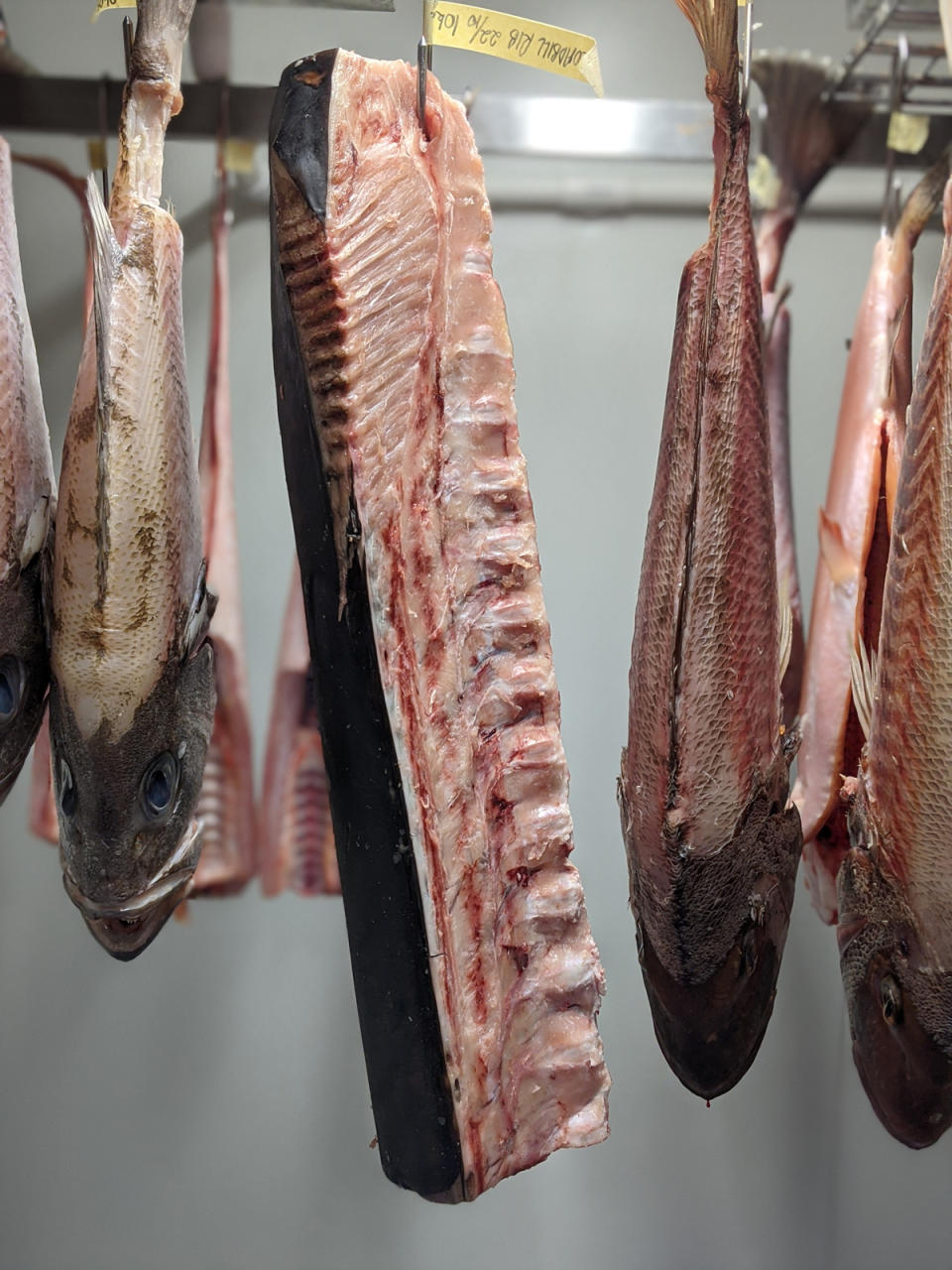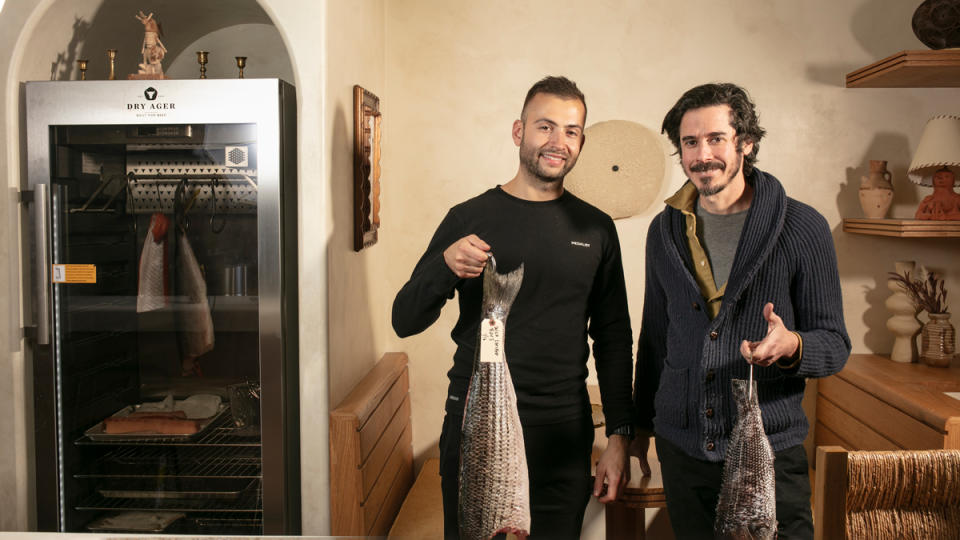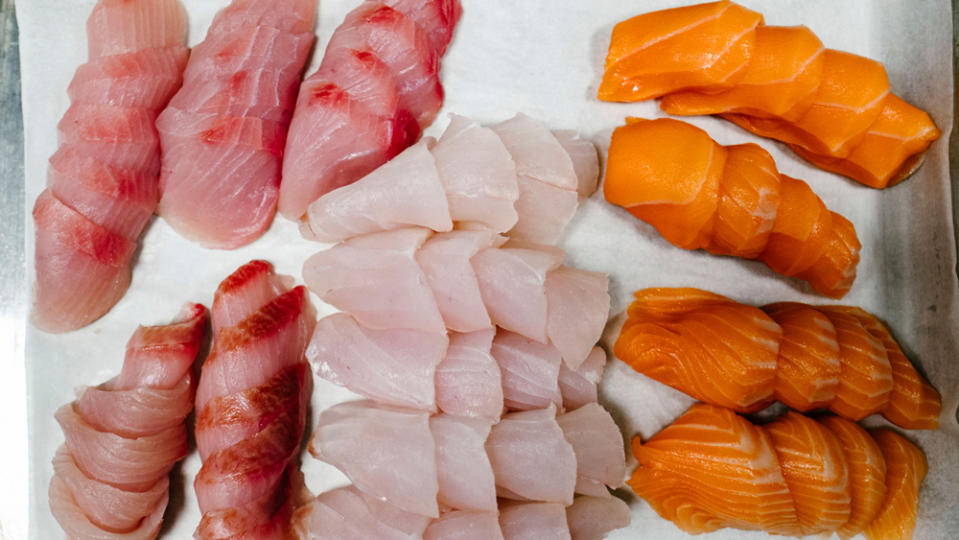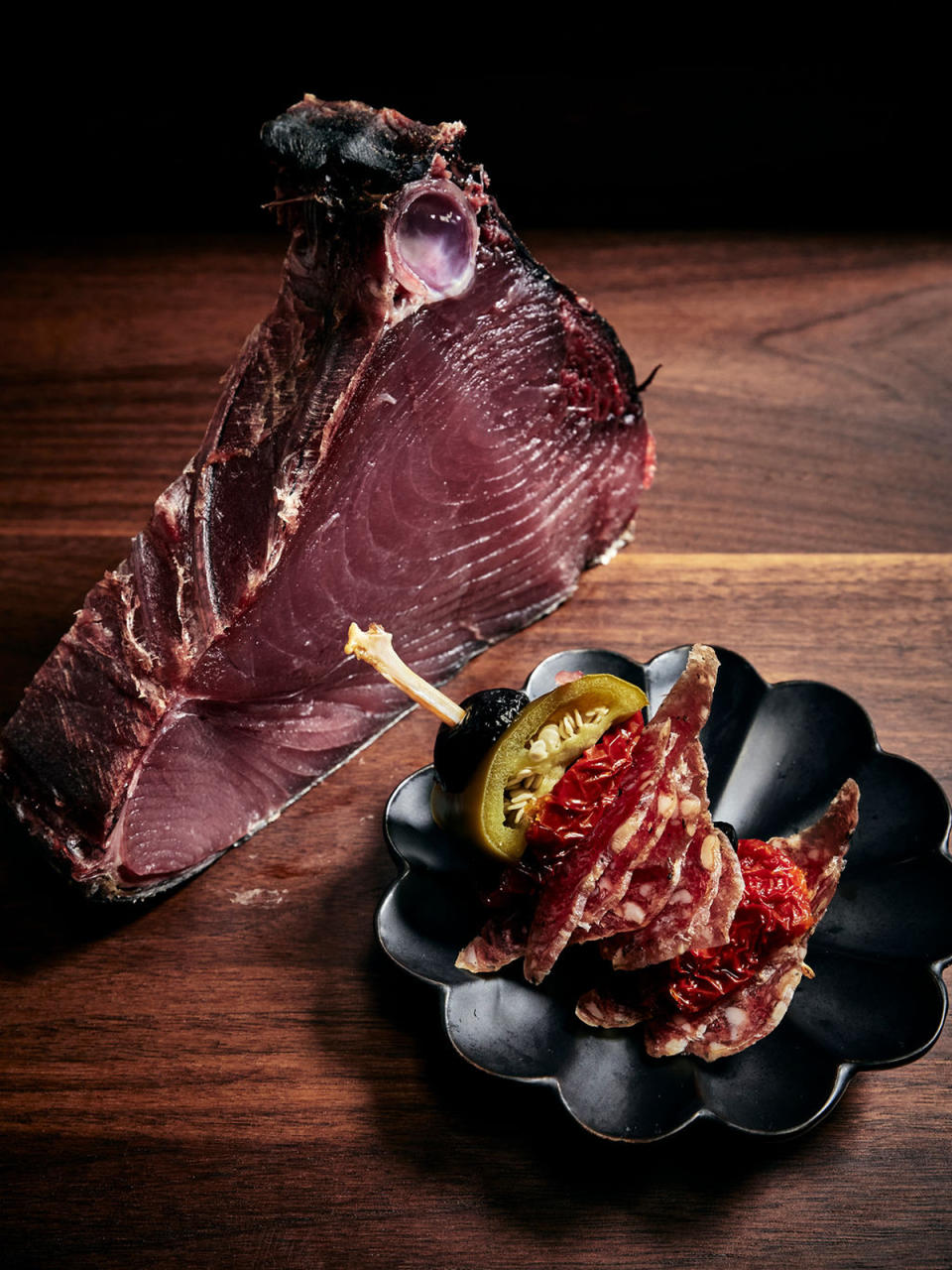How Dry-Aged Fish Took the Fine Dining World by Storm

One night, as an 18-year-old line cook at Fish Face in Sydney, Josh Niland forgot to transfer 15 uncooked portions of kingfish from a service refrigerator back to the walk-in. The next day, he got an earful. Rather than being tucked beneath a sheath of plastic wrap and placed in a 0°C room, a fan had blown on the fish all night and dried out the skin. Other than appearances, though, Niland didn’t see anything wrong with the fish, and with his head chef out of the restaurant, he cooked it anyway.
Niland remembers his first order coming in. He heated clarified butter in a pan and slipped in the fish. “All of a sudden, the fish actually inflated off the pan,” he says. “The skin had this big crackling bubble in the top of it, and everybody was like, ‘Wow, this is amazing.’ But I didn’t do it again. I just wrote it down in my notebook.”
More from Robb Report
A San Francisco Billionaire Wants to Keep People Off the Beach Near His Home. A Judge Just Said No.
Watch: How to Make the Delicious Shrimp Parm at N.Y.C.'s San Sabino
A California Beach House With a Guitar-Shaped Pool Just Listed for $15 Million
That mistake and notebook entry sparked Niland’s multi-concept, multi-continent sustainable seafood restaurant group—and the global phenomenon that is dry-aged fish. If you haven’t eaten dry-aged fish, or noticed it on restaurant menus, you will soon. Since the release of Niland’s 2019 The Whole Fish Cookbook, the technique has been adopted by chefs in fine dining, neighborhood spots, sushi counters, and any number of seafood-focused restaurants. American seafood distributors have started dry-aging fish to order.
The problem with fish, of course, is that they stink after three days, especially when handled poorly and held at unstable temperatures. That pungent aroma you associate with a fish market is ammonia, which forms when dead fish get rinsed in water—a near universal practice, says Niland. For millennia, cooks have solved the whole rotting thing with preservation techniques like pickling, smoking, and salting. Japanese sushi chefs, with the aid of refrigeration, also began to mature fish by wrapping and stuffing them with absorbent towels, wicking away moisture.

But in the world of high-end cuisine, chefs solve for decay by throwing away fish. “Every high-achieving, Michelin-starred restaurant in the world will purchase a fish on the day [they need it],” says Niland, who owns fine-dining St. Peter, Petermen, and a forthcoming hotel in Sydney and Fysh in Singapore. “If it’s not sold, it doesn’t matter. You’ve got to get a new fish tomorrow because fresh is best.”
In Niland’s approach, which he prefers to call “intentional moisture loss in controlled environments,” fish are scaled and gutted (entrails get saved for fermentation projects); butchers wipe out the cavities and hang them by the tail in a 0°C room with no fan. Some fish might rest there for less than a day, and others for weeks. None of them rot.
But extended shelf life alone isn’t enough to send chefs into a frenzy. Dry-aging also eliminates waste, a boon for small businesses and an appeal for sustainability-minded chefs. It allows smaller restaurants to buy more and larger fish. As with dry-aged meats, enzymes in fish flesh break down fats and proteins into fatty acids and amino acids, including umami-packed glutamate. With different species, fat contents, cuts, and aging times, the technique is ripe for experimentation.
At a recent dinner at St. Peter, I popped a morsel of Murray cod chorizo into my mouth and nearly squealed with delight. A pie-shaped wedge of meaty coral trout sat atop a pile of fennel and fermented coral trout tripe, and the meal crescendoed with an impossibly rich, 12-day aged piece of yellowfin.

“It’s exciting for cooks. It’s fun,” says Tomer Blechman of aging’s creative potential.
Blechman recently opened wood-fired, seafood-focused Theodora in Brooklyn, and the chef dry-ages hiramasa for a crudo with finger lime, avocado, and dashi, along with 20-pound, Montauk-caught tile fish he says take 10 days to reach optimal texture. While Niland built a special refrigerated room for his aging, at Theodora, Blechman purchased two dry-ager machines. Designed for beef but now widely sold for fish, the machines’ efficacy and ease of use has helped the technique proliferate. They also look dope in a dining room.
When Blechman started researching his concept, he consulted with the team at Spanish-Portuguese Porto in Chicago about their dry-ager. In Los Angeles, Michael Cimarusti uses a dry-aging machine, as does Josiah Citrin at Charcoal Venice. In Sherman Oaks, the Joint’s motto is “fresh is boring,” and owner Liwei Liao has built a cafe, seafood market, and wholesale business all based on dry aging. The Lucky Robot in Austin installed an ager for its Japanese menu. Longtime seafood innovator Michael Nelson of GW Finns in New Orleans now dry-ages bright red slabs of bluefin tuna. The list goes on.
New York Chef James Kent will install dry agers in his upcoming seafood restaurant, and by the end of the spring, the West Village will have (at least) two new Italian restaurants with dry-aging programs, Alaluna from chef Riccardo Orfino and Harold Dieterle’s Il Totano. Dieterle, an avid fisherman, got into dry aging during pandemic down time, and at Sicilian-inspired Il Totano, he will serve a rotating selection of fish, including dry-aged tuna (he likes an 80 to 100-pound tuna rested for seven to 10 days) and Kona Kampachi for crudos. Two-day-aged branzino will hit a Japanese binchotan grill before being paired with a confit tuna collar sauce, Sicilian green beans, Castelvetrano tapenade, and tomatoes.
Restaurants in almost any context, location, and style can apply dry aging, says Niland. “The genius of Ferran Adria, Rene Redzepi, Massimo Bottura, and Daniel Humm aren’t tangible to everyone, because they’ve got a brigade and every bit of infrastructure at their fingertips. But fish has no boundaries, and to suggest that we just need to look at it slightly differently, that’s tangible.”

For Nick Bognar, a landlocked sushi chef in St. Louis, dry aging means he can import exceptional Japanese fish for his omakase program at Sado. He hangs kinmedai for 24 to 48 hours before slicing the flesh for sashimi and sushi. Texture is Bognar’s raison d’etre for aging. “It makes fish so much more dense with fat; the mouthfeel is so much better,” he says. “You also get this bonus that it’s more true to the fish’s flavor. Kinmedai pretty much eats crustaceans and shellfish, and you really get those notes rather than having a less identifiable, fresh-tasting snapper.”
At San Francisco’s Aphotic, aging fish is part of a larger mission to rewrite restaurants’ relationship with seafood. Chef Peter Hemsley buys exclusively local and mostly lesser-known species; dry-aging, he says, is one small manifestation of respect for ocean resources and fishermen. “We deny ourselves a lot of what’s out there internationally and accessible to anyone willing to pay for it,” says Hemsley, who owns six dry agers. “That spawned things like buying in massive stock from some of the local guys.”
Preservation—whether that’s freezing, pickling, or aging—is essential to Aphotic’s ethos. Hemsley ages fish, including tuna and rockfish, but he has also cured tuna saucisson sec and he’s developing house katsuobushi, the Japanese-style smoked and dried bonito that’s essential to dashi.
As the technique has proliferated, Niland has looked on with a combination of awe, curiosity, and trepidation. “I’ve always thought if you can’t share your work, then it doesn’t mean anything, but I got nervous seeing it on Instagram,” he says. “It was scary to see people aging fish that hadn’t been killed properly or that just looked absolutely disastrous to begin with.”
Pristine seafood means different things to different people, but if a chef is dry-aging fish, they should be able to tell you how it was caught, killed, and the quality of the water it swam in.
Niland sources wild-caught fish directly from fishermen who harvest with the ike jime method, which reduces stress and improves the quality of the catch. But he says farm-raised fish, with their higher fat content, perform especially well in dry-agers.

Typically, the fattier the fish, the longer it can age. Liao of the Joint has pushed salmon to 44 days and tuna to 70, and with dry-aging, the lines between excess, optimal outcome, taste, and technical innovation are still being drawn.
For his Michelin two-starred, micro-seasonal Ikoyi in London, chef Jeremy Chan built a custom aging chamber, where he hangs wild-caught species like mackerel, mullet, sea bass turbot, river trout, and skate. Chan grew up in Hong Kong with an appreciation for freshly killed, “explosive, juicy” seafood. “My idea of delicious fish is that it has collagen, moisture, and texture. It’s bouncy, but it melts in the mouth,” he says. “When I’ve aged turbot too long, I find it sort of steak-y or ham-y. It’s impressive, but it’s not necessarily delicious to me. I’m always trying to toe the line between drying my fish while retaining its explosive vitality.”
Aging for aging sake doesn’t appeal to Chan. Most guests don’t know about his aging chambers, tucked away in the back of house. Waiters don’t lecture diners on the technique, and he’s wary of its trendiness. “I’m a huge supporter of people who can do it with the right fish and with the right practices, but I’m also a skeptic,” he says.
But what Niland, his books, and Instagram have unleashed won’t recede anytime soon. Not with dry agers popping in dining rooms, fish stocks at risk, seafood costs rising, and chefs finding out that fish have vastly more creative potential. “We all have an affinity to fish, and I think all of us get a little bit concerned when we hear that it might not be around forever,” Niland says. “This hits people in all different ways. But chefs probably get most excited because for forever, they’ve been told to prepare fish a certain way, and it’s almost rebellious to go the other way and to achieve something different.”
Best of Robb Report
Why a Heritage Turkey Is the Best Thanksgiving Bird—and How to Get One
The 10 Best Wines to Pair With Steak, From Cabernet to Malbec
Sign up for Robb Report's Newsletter. For the latest news, follow us on Facebook, Twitter, and Instagram.

